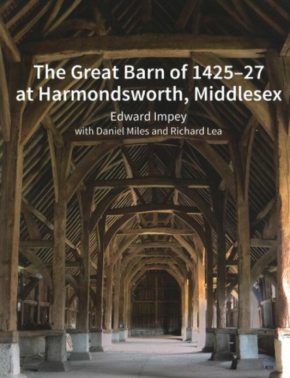The Great Barn of 1425-27 at Harmondsworth, Middlesex

|
| The Great Barn of 1425-27 at Harmondsworth, Middlesex, by Edward Impey with Daniel Miles and Richard Lea, Historic England, 2017, 89 pages, 31 colour and black and white illustrations, paperback. |
It is sadly ironic that half a century ago the late Ian Nairn contrasted the architectural majesty of the great barn at Harmondsworth with the mediocrity of the neighbouring aircraft hangers a short distance away at Heathrow (Nairn’s London, Penguin Books, 1966). Soon, if the proposed northern runway at the airport goes ahead, the setting of this medieval masterpiece will be irrevocably destroyed, together with the total removal of one conservation area and the decimation of another.
It is perhaps too much to hope that wiser counsels will prevail following the publication of this meticulously researched book. In the language of the National Planning Policy Framework, the barn is a building of the highest national significance, and in accordance with Conservation Principles the book is a major contribution to our understanding not only of this fine example but also of the purpose and function of large medieval barns in general.
Firmly dated to 1425–27 both by dendrochronology and documentary evidence, it was built for William of Wykeham’s Winchester College, which had purchased the estate in 1392. The assembly of former monastic estates to provide an endowment for Wykeham’s complementary foundations of Winchester and New College, Oxford, is described in the opening sections, followed by a detailed discussion of the motivation and possible cost of building the Harmondsworth barn. A minute structural analysis of every element of the fabric is concluded with an instructive exposition on how the details of the carpentry can be used to speculate on the sequence of erection of the timber frame. The argument is clearly illuminated by a staged series of 24 three-dimensional diagrams in full colour.
A lengthy exploration of the function of the barn is based on extensive documentation, embracing changes in agricultural practice on the manor, the yields and harvesting of the various crops and their processing, and the officials and labour involved throughout the farming year. The context for the barn and its enormous size is provided by comparison with other medieval barns, with tables listing basic details of the 19 largest barns in England, and the 12 largest barns in France and Flanders. Although this section ranges across much of southern and midlands England and across the channel in northern Europe, it would have been helpful to have looked at some other surviving examples built for pre-Reformation institutions closer to Harmondsworth in the Greater London area.
These might have included the great barn on another Winchester manor of Ruislip, the Archbishop of Canterbury’s barn close by at Headstone, which provides clear evidence in its fabric for the farming of the demesne, and the Hall barn at Upminster, Essex, owned by Waltham Abbey and with similar vertical boarding to the cladding at Harmondsworth.
The manor of Harmondsworth passed out of monastic tenure in 1543. The subsequent ownership is traced until the barn ceased to be used for agricultural purposes in 1986 and was bought by a building company. Some repairs were carried out before the company fell into receivership and after a lengthy period of uncertainty English Heritage took the brave decision to purchase it ‘for the nation’ in 2011. Under its responsible stewardship the barn was fully restored in 2014 and is now open for public access for the first time in 500 years.
It was a remarkable initiative and I would urge everyone to support it by making a pilgrimage to enjoy what John Betjeman described as one of the ‘noblest medieval barns in the whole of England’ before the tranquillity of its setting is shattered by the noise of jet engines. There they will be able to see the quality of the craftsmanship of the original fabric and the sensitive restoration. Armed with the scholarship in this definitive book they will be able to appreciate why it was built and how it has functioned throughout its long history. It is an exemplary study of the design and architectural significance of a great medieval building and is highly recommended.
This article originally appeared as ‘The noblest in England’ in IHBC’s Context 154, published in May 2018. It was written by Malcolm Airs, Kellogg College, Oxford.
--Institute of Historic Building Conservation
Related articles on Designing Buildings
IHBC NewsBlog
Old Sarum fire in listed (& disputed) WW1 Hangar - Wiltshire Council has sought legal advice after fire engulfed a listed First World War hangar that was embroiled in a lengthy planning dispute.
UK Antarctic Heritage Trust launches ‘Virtual Visit’ website area
The Trust calls on people to 'Immerse yourself in our heritage – Making Antarctica Accessible'
Southend Council pledge to force Kursaal owners to maintain building
The Council has pledged to use ‘every tool in the toolbox’ if urgent repairs are not carried out.
HE’s Research Magazine publishes a major study of the heritage of England’s suburbs
The article traces the long evolution of an internal programme to research 200 years of suburban growth
IHBC Context 183 Wellbeing and Heritage published
The issue explores issues at the intersection of heritage and wellbeing.
SAVE celebrates 50 years of campaigning 1975-2025
SAVE Britain’s Heritage has announced events across the country to celebrate bringing new life to remarkable buildings.
IHBC Annual School 2025 - Shrewsbury 12-14 June
Themed Heritage in Context – Value: Plan: Change, join in-person or online.
200th Anniversary Celebration of the Modern Railway Planned
The Stockton & Darlington Railway opened on September 27, 1825.
Competence Framework Launched for Sustainability in the Built Environment
The Construction Industry Council (CIC) and the Edge have jointly published the framework.
Historic England Launches Wellbeing Strategy for Heritage
Whether through visiting, volunteering, learning or creative practice, engaging with heritage can strengthen confidence, resilience, hope and social connections.














